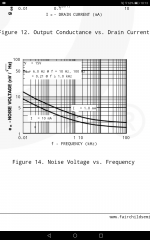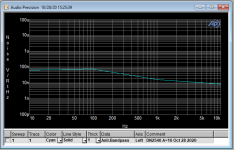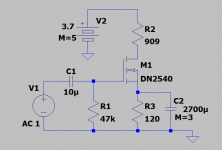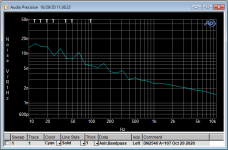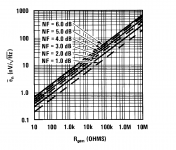Question to bdef: What is the desired noise level with connected source? When will you be satisfied?
PF5102 on the graph is process 51 jfet, I guess that J111 family is similar? Any links for the noise measurement of J112/113?
If you're talking about the En vs Id graph I attached, then no: it's a Toshiba 2SK147, it has a large geometry, a Yfs of 40mS, an En of about .7nV/SQRT(Hz) @1KHz, and of course, unobtanium. Attached is a full datasheet from Sanyo, which is technically the same as the Toshiba.
The J111, with its medium geometry, a Yfs < 20mS, and a En of 2nV/SQRT(Hz) @1KHz is not in the same league.
Attachments
I don't have noise measurements or noise specs for DN2540, but have built some amplifiers with it and found it to be very quiet. Run at about 5 to 20mA, and cascode it to eliminate g-d capacitance variations with voltage. With a cascode and source degeneration resistor (about 300 ohms) to set its current, it will have extremelt high input impedance limited only by bias resistor and is capable of quite low distortion, too. (Running at higher Vds might work rather than a cascode, I didn't though).
Not at all in the same class, here's some input noise data -- running @16mA, gain=10
Attachments
Question to bdef: What is the desired noise level with connected source? When will you be satisfied?
That is actually the real question.
If I can't hear noise in my couch, then I'm happy. I don't have sensitive speakers and my amplifier at the moment is LM3886 based and my PU is a 2M Red. I don't se myself as extreem in that way.
My RIAA is based on a LT1113, so I think my real question is the 6nV noise in the LT1113, what does that compare to in a JFET where it's noise is in dB.
By the way. I mentioned the JFETS that my local supplyer have in stock that I think is interesting. I could buy from China using Ebay but that at some point I wouldn't have my local suppier and the stuff I buy might be genuine and might not. I have reasons (political?) for using my local supplyer even though they have a limited posibilities.
Why does it level off and even slightly drop below 100 Hz?
Re ran the test again with a bunch of DN2540's -- the graph below is the best one.
Reconsidered the setup and ran the test from 1kHz to 10kHz, 18.5V supply (5x Lithium 18650 cells), Rd=909R, Rs=120R with 2.7mF * 3 in parallel.
Edit -- as a sanity test ran with a 22k resistor which should have 18.9nV/Rt Hz noise)
Attachments
Last edited:
That is actually the real question.
If I can't hear noise in my couch, then I'm happy. I don't have sensitive speakers and my amplifier at the moment is LM3886 based and my PU is a 2M Red. I don't se myself as extreem in that way.
My RIAA is based on a LT1113, so I think my real question is the 6nV noise in the LT1113, what does that compare to in a JFET where it's noise is in dB.
Do you care about the noise in between records? With a record playing, record surface noise will dominate unless the MM RIAA amplifier is really bad.
Regarding the LT1113, neglecting its very small current noise:
typical 4.5 nV/sqrt(Hz) -> roughly 3.5 dB noise figure with respect to 1 kohm, 0.004 dB with respect to 1 Mohm, all at 1 kHz
typical 4.5 nV/sqrt(Hz) -> roughly 3.5 dB noise figure with respect to 1 kohm, 0.004 dB with respect to 1 Mohm, all at 1 kHz
Thanks.
If I look at 2N5459 (Noise: 3dB / 1MOhm) and 2SK117 (Noise: 1dB / 1KOhm) does this then mean that the 2N5459 is 62dB more noisy than 2SK117?
The differende between 1MOhm and 1KOhm must be 1000 times = 60 dB and then 2 dB more (3-1) = 62 dB?
It sounds like a lote to me. Hope I have misunderstood something, as otherwize 2N5459 isn't must usefull in audio.
Just for fun. Is it possible to calculate the S+N/N ratio? My preamp will (as worst) have an Rg (middle of potentiometer) of arround 10KOhm and we can say the signal to be 100mV.
If you (anybody) can the formula I'd like to see it.
http://www.mit.edu/~6.301/2N5459.pdf
https://www.futurlec.com/Datasheet/Transistor/2SK117.pdf
If I look at 2N5459 (Noise: 3dB / 1MOhm) and 2SK117 (Noise: 1dB / 1KOhm) does this then mean that the 2N5459 is 62dB more noisy than 2SK117?
The differende between 1MOhm and 1KOhm must be 1000 times = 60 dB and then 2 dB more (3-1) = 62 dB?
It sounds like a lote to me. Hope I have misunderstood something, as otherwize 2N5459 isn't must usefull in audio.
Just for fun. Is it possible to calculate the S+N/N ratio? My preamp will (as worst) have an Rg (middle of potentiometer) of arround 10KOhm and we can say the signal to be 100mV.
If you (anybody) can the formula I'd like to see it.
http://www.mit.edu/~6.301/2N5459.pdf
https://www.futurlec.com/Datasheet/Transistor/2SK117.pdf
If noise is all that matters, you could go for the 2SK170, otherwise the 2SK117. Toshiba`s measuring method may be different. Circuit topology has a far more decisive role than the impact of device choice. The important voltage amplification should be carried out by bipolar transistors.
Thanks.
If I look at 2N5459 (Noise: 3dB / 1MOhm) and 2SK117 (Noise: 1dB / 1KOhm) does this then mean that the 2N5459 is 62dB more noisy than 2SK117?
The differende between 1MOhm and 1KOhm must be 1000 times = 60 dB and then 2 dB more (3-1) = 62 dB?
The resistance is below a square root, so theoretically the difference is 32 dB - which is still a lot.
However, that 3 dB at 1 Mohm for the 2N5459 is in the maximum column of the datasheet. The exceedingly high value can simply mean that Fairchild used a cheap production tester that can't measure noise very well or that they had difficulties measuring noise properly in a production environment with lots of interfering equipment. It can also mean that their process was not that good and occasionally produced a very noisy device.
In any case, when you look at the second graph at the last page of the datasheet you linked to, you see that the typical noise at 1 mA drain current is only 4 nV/sqrt(Hz).
Re ran the test again with a bunch of DN2540's -- the graph below is the best one.
Reconsidered the setup and ran the test from 1kHz to 10kHz, 18.5V supply (5x Lithium 18650 cells), Rd=909R, Rs=120R with 2.7mF * 3 in parallel.
Edit -- as a sanity test ran with a 22k resistor which should have 18.9nV/Rt Hz noise)
Whew that’s noisy.
> both are just fine for a moving-magnet RIAA ....
Depends on your requirements.
Patrick
Of course, hence my question whether bdef cares about the noise in between records.
Assuming the answer is yes, with a 500 mH cartridge inductance, 4 nV/sqrt(Hz) produces about 5 dB less RIAA- and A-weighted noise than the 47 kohm termination resistor, and when I urge people to replace their termination resistors with something less noisy they usually write that they find that overdone.
Uh-uh, the "termination resistor" is shunted by the internal resistance of the cartridge, typically a K or so for a moving magnet.
- Home
- Amplifiers
- Solid State
- What JFET should i choose for a preamp?
